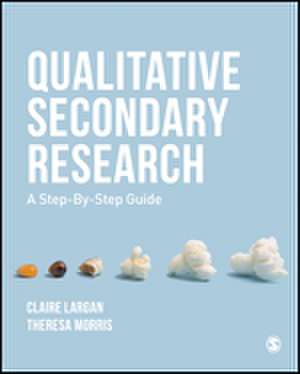Qualitative Secondary Research: A Step-By-Step Guide
Autor Claire Largan, Theresa M. Morrisen Limba Engleză Paperback – 22 apr 2019
Perfect for those doing dissertations and research projects, it provides an accessible introduction to the theory of secondary research and sets out the advantages and limitations of using this kind of research. Drawing on years of teaching and research experience, the authors
· Offer step-by-step advice on how to use qualitative secondary data
· Walk you through each stage of the research process
· Provide practical, ethical tools to help you with your project
· Show you how to avoid the potential pitfalls of using secondary data.
Clear and easy to understand, this book is a ready-made toolkit for successfully using qualitative secondary data. From beginner level and beyond, this no-nonsense guide takes the confusion and worry out of doing a secondary research project.
| Toate formatele și edițiile | Preț | Express |
|---|---|---|
| Paperback (1) | 344.48 lei 22-36 zile | +32.92 lei 5-11 zile |
| SAGE Publications – 22 apr 2019 | 344.48 lei 22-36 zile | +32.92 lei 5-11 zile |
| Hardback (1) | 891.83 lei 43-57 zile | |
| SAGE Publications – 6 mai 2019 | 891.83 lei 43-57 zile |
Preț: 344.48 lei
Nou
65.94€ • 71.65$ • 55.42£
Carte disponibilă
Livrare economică 31 martie-14 aprilie
Livrare express 14-20 martie pentru 42.91 lei
Specificații
ISBN-10: 1526410982
Pagini: 368
Dimensiuni: 186 x 232 x 26 mm
Greutate: 0.63 kg
Ediția:1
Editura: SAGE Publications
Colecția Sage Publications Ltd
Locul publicării:London, United Kingdom
Recenzii
Overall, the authors have written a well thought out, accessible and comprehensive book, which is a welcome addition to a relatively small literature on secondary data and documentary analysis.
I will definitely be using this in my own research, to ensure that I have not forgotten important elements in my research design and analysis, and will be recommending chapter 5 (ethics in qualitative secondary research) as additional reading in the ethics chapter of my forthcoming book aimed at undergraduate student
Cuprins
Chapter 2: Preparing for Qualitative Secondary Research
Chapter 3: The Role of Theory in Qualitative Secondary Research
Chapter 4: Designing Qualitative Secondary Research
Chapter 5: Ethics in Qualitative Secondary Research
Chapter 6: Exploring Documents as Data
Chapter 7: Locating your Data
Chapter 8: Securing Quality over Quantity
Chapter 9: Constructing a Literature Review
Chapter 10: Managing your Data
Chapter 11: Analysing Data
Chapter 12: Working with Numbers
Chapter 13: Presenting your Findings and Conclusions
Chapter 14: Being a Qualitative Secondary Researcher
Notă biografică
Dr Claire Largan, MA, PhD, is an Independent Research Consultant specialising in education policy and practice.
Claire¿s career embraces UK and international contexts with its basis firmly within the realm of education, learning, teaching and research. Formerly a lecturer in education at University College Birmingham, Claire is now a successful research consultant working within the field of education policy and practice.
She began her career as an early years and primary school teacher before gaining significant international experience teaching overseas in international schools in Dubai and Taiwan and teaching on English programmes offered by the British Council in Dubai. As an experienced lecturer, she has developed, designed and worked on a range of undergraduate and postgraduate programmes and been an external examiner for well-known UK institutions.
With over ten years¿ experience of teaching research methods at undergraduate and postgraduate levels, Claire has supported many students both in UK and international contexts, specialising in working with students undertaking secondary research projects. Her own specialised research expertise lies in the use of visual methods of data collection and she was awarded her PhD by the University of Birmingham in 2016 when she also received a Postgraduate Diploma in Research in Education.
Underpinning her rationale for co-writing this book is her substantial experience of working with learners from various levels of educational experience and diverse linguistic and cultural backgrounds. Her rationale to co-write this research book was a desire to demystify secondary research processes and practice and to do this in an academic, informative, accessible and student-focused way and, specifically, one that draws upon visual approaches to communication.
